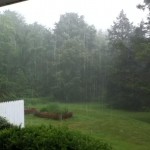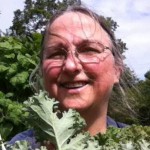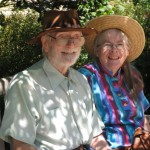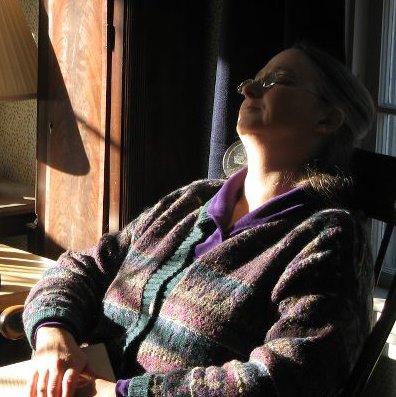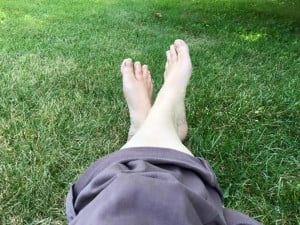Twenty-five years ago, or the day before yesterday in subjective time, my friends and I spent a day laboring in the summer heat to build a ritual circle in a clearing in the woods.
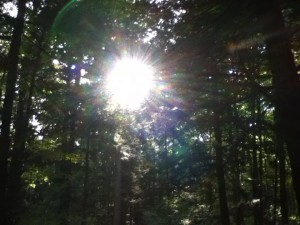
We lifted rocks, we gathered refuse and scraps of wood, dug a firepit, and erected a small standing stone. For the next five years, we used it often, gathering with other Pagans there for worship, camping in the deep, green moss nearby, and building trails and small shrines all around it in the woods. It was a quiet place, and I loved it. To this day, if I want to remember the feeling of magic, of hearts joined in Pagan community, all I need to do is find myself the smell of white pines and woodsmoke, and I am home.
But I fell in love, and I moved away, and life marched on, and I didn’t always return. Somehow, I looked up, and decades had past since I had been in those woods.
And then I had the chance to go home again.
For many summers now, the beginning of August has been reserved for me and for my husband to visit the annual sessions of New England Yearly Meeting of Friends–of Quakers. For a week, we would bunk together in an off-season college dorm room, spending our days in worship, in small group workshops and discussions, and in business meetings that last for most of the day–meetings in which six or seven hundred Quakers seek Unity with the Holy Spirit, in an atmosphere that alternates between mind-numbing boredom and the deepest worship experiences I have ever known.
It has been wonderfully sustaining and meaningful. But just because they have a 350 year prior claim to it does not mean I haven’t resented the fact that New England Quakers planted their annual business meeting and gathering right smack dab in the middle of Lughnassadh. And they don’t even celebrate it!
Last year, we broke with tradition, and in spite of the fact that it would keep us from attending Sessions, we accepted an invitation to the Laurelin Community’s annual celebration of Lughnassadh, up in those same woods I used to know, where a much smaller group of people come together every year. And it was lovely.
Except.
They had gone and moved the trees.
Literally, enough time had passed that the trees were in different places than the trees that I’d remembered. I could not even find the old ritual circle at first: there were clearings where there had been trees, and trees where there had been clearings, and nothing, nothing was the same.
Now, white pines are an especially quick-growing species, and not especially long-lived. Plant a dozen white pine saplings when your child is born, and he will find a grove of giants when he is in his prime. Wait another few years, and when that same man is old, the trees will be old along with him, and when he has died, most of the trees will by dying, too. Walk in the shade of white pines, and you will feel that you are walking in eternity, in a land that has been unchanged since the dawn of time.
But wait a few decades, and you will learn how much of an illusion unchanging time really is. White pines are ready to teach you: you can’t go home again.
That’s life.
The only things of permanence we human beings have ever created have been dead. Cathedrals and pyramids, coliseums and roads, things of stone can last a long, long time. But even a redwood tree, even a thousand-year-old yew tree, is dying.
That’s what makes it alive.
My husband and I have a small outdoor altar at our new home. It’s only a small shelf, fitted to the shape of a hemlock tree. We keep icons on it in the summer, and leave small offerings of bread and beer, or berries, flowers, and herbs.
Our hemlock tree is dying, yet another victim of the blight of woolly adelgids that are destroying so many New England hemlocks right now. From where I sit as I write these words, I see many bare branches–perhaps a third of all it has–poking like bones beneath the cloak of green boughs on the rest of the tree.
But hemlocks are tough old trees, and every few years, this tree rallies, puts out another bumper crop of needles, and–if the winter was harsh enough to kill off many of the adelgids–makes up a little lost ground. We’ve hired an arborist, who has done what he could. The tree has good years, and the tree has bad years. But in point of fact, our altar tree is dying. Sooner or later, it will be dead.
We’ve known that all along; it was one of the reasons we chose that tree to hold our altar. Our tree is dying; our tree is full of life. Those two facts are not actually in tension. The dead limbs are home to insects, and the insects feed the birds. A pair of
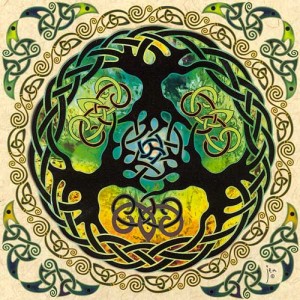
cardinals especially love our tree, but so do chickadees and robins, finches and juvenile hawks. Toadstools are growing from its dying roots, brambles have taken root in a crook between its trunks, and rabbits shelter in its shadow as they crop grass from our lawn.
Every tree is Yggdrasil, with worlds in its roots and branches, gnawed at and dying, alive and giving life.
How could we expect a thing so sacred ever to stay unchanged?

